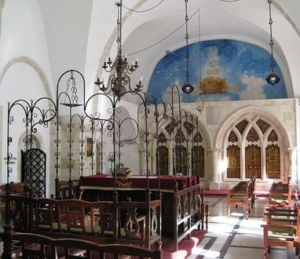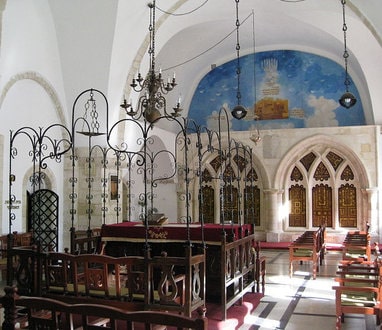The Four Sephardic synagogues
 When we walk in the Old City of Jerusalem, it is not uncommon to see religious men running from one place of prayer or study to another one. You have probably heard about the Hurva Great Synagogue in the Jewish Quarter or the famous roofless Tifferet Synagogue, but are you familiar with the complex of synagogues named the Four Sephardic Synagogues in the Old City of Jerusalem?
When we walk in the Old City of Jerusalem, it is not uncommon to see religious men running from one place of prayer or study to another one. You have probably heard about the Hurva Great Synagogue in the Jewish Quarter or the famous roofless Tifferet Synagogue, but are you familiar with the complex of synagogues named the Four Sephardic Synagogues in the Old City of Jerusalem?
This complex of synagogues became essential to the Sephardic community of the Old City, which played an outstanding role in keeping the Jewish presence within the walls of the city over the centuries. It is particularly thanks to Ramban (Rabbi Nachmanides) that this community resumed its growth in the thirteenth century, and again in the early sixteenth century with the expulsion of Jews from Spain and Portugal.
These 4 adjoining Sephardic synagogues were destroyed by the Jordanian Legion during the Independence War of the State of Israel and then refurbished 20 years later after the Six Day War, just like the Hurva Synagogue.
● The Yochanan Ben Zakai Synagogue
This first synagogue is named after one of the greatest Talmudists of the time of the destruction of the Second Temple (first century of our era) who relocated the Sanhedrin from Jerusalem to the city of Yavneh. According to local beliefs, this synagogue would be on the ancient Beit Midrash (ie the Jewish study center) of Rabbi Yochanan Ben Zakai. In this synagogue, we may find many objects like the jug and Shofar (ram's horn) exposed in the window (at height) symbolizing the arrival of redemption, objects that have been preserved in the synagogue since the destruction of the temple. Do not hesitate to ask your guide what you may see in this splendid synagogue!
● The Eliyahu Hanavi Synagogue
Since the Sephardic Jewish community increased with time, especially in the sixteenth century, the needs of the community grew, which led to the opening of a new synagogue. Thus, the first synagogue to be added to that of Rabbi Yochanan Ben Zakkai is that of Eliyahu Hanavi. This synagogue has a Holy Ark built by the Jewish community of Spain and was brought to Israel at the time of the expulsion of the Jews from Spain. This synagogue is full of symbols and legends ... As you may have guessed, the name given to this synagogue is related to a local history! A history that would have occurred in the seventeenth century following an "exceptional" event with the prophet Elijah, during the day of Yom Kippur ... Are you curious to learn more? Then visit the place!
• The Middle Synagogue
No, no ... it is not a synagogue hidden on the Middle Earth of the Lord of the Rings! The Jews are not everywhere (at least not yet, humor of our guide-writer)! This synagogue is located exactly between the synagogues of Eliyahu Hanavi and Rabbi Yochanan Ben Zakkai, which is why it is called the "synagogue of the MIDDLE". It was built for the same reasons of the Eliyahu Hanavi’s Synagogue. In the eighteenth century, the Jewish community increased and this corridor was renovated and transformed into a new prayer space.
Today, this synagogue is no longer used as a place of prayer. It was transformed into a museum with a permanent exhibition of photographs and artifacts of the Jewish community over the years. Among the artifacts you may find, a Sefer Torah (the only one) which was not burnt during the War of Independence in 1948, protected and preserved by a Christian who later brought it back to the Jewish community some 19 years later, at the reunification of the city, after the Six Day War.
● The Istanbuli Synagogue
This synagogue stands out due to its square structure and its size with a semicircular dome in the center ... You may notice the windows on the ceiling allowing the sun's rays to naturally enlighten the room. It has a mixture of different architectural styles, namely Byzantine and Muslim.
As its name indicates, this synagogue was the center of prayer of the Turkish Jews in Jerusalem while today the Portuguese rite is practiced there. You may admire a beautiful picture of the great Portuguese synagogue of Netherlands. It seems that this space and the surrounding complex was a shelter for the poor and widows. Do not hesitate to ask your guide about the meaning of religious objects (such as the Bimah at the back of the synagogue) and other inscriptions that you may find in this synagogue! There are little mysteries to discover!

